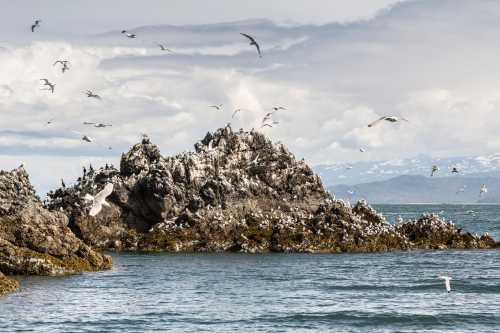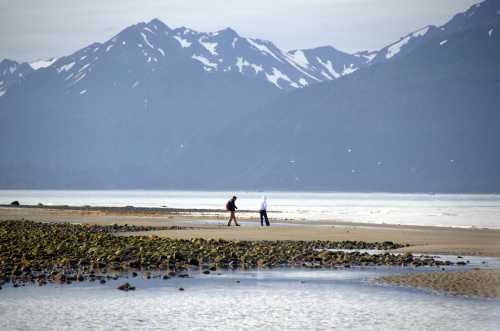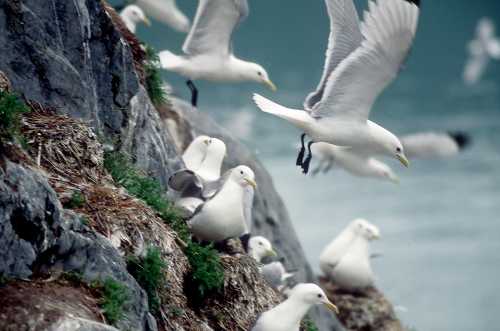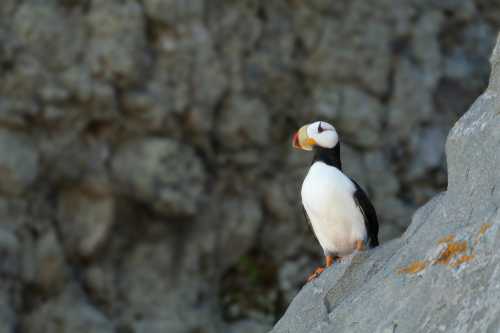If you’ve ever dreamed of standing on the edge of the world, surrounded by the sound of waves crashing, birds calling, and maybe a puffin waddling by, then pack your binoculars and head to Alaska Maritime National Wildlife Refuge. Located along the state’s rugged coastlines and stretching across the vast Aleutian Islands, this refuge is not just a collection of isolated islands — it's a birdwatcher's utopia and one of the most spectacular marine ecosystems in the world. With its rich history, vibrant wildlife, and jaw-dropping views, it’s a spot where nature lovers, especially bird nerds, can lose themselves for hours … or days.
The Alaska Maritime National Wildlife Refuge is comprised of more than 2,500 miles of coastline and spans from the Aleutian Islands to the Southeast Panhandle. It's as vast as it is breathtaking. And if you’re into birdwatching — or if you’ve never given it a shot but secretly know you’d rock a pair of binoculars — this place is sure to convert you to a birder in no time. (It happens to us all, eventually!)
Of course, with so much ground to cover, it's nearly impossible to see every corner of this spectacular refuge. Your best bet is to start your adventure in Homer, the charming small town on the Kenai Peninsula that serves as the gateway to this remote paradise. Homer itself is worth exploring too (fish tacos, anyone?), but the real treasure lies just up the road at the Alaska Islands & Ocean Visitor Center, your launchpad for exploring the refuge and a fantastic gateway to one of the most expansive, wild, and bird-filled refuges on the planet.
The Center is an incredible one-stop shop for learning about the diverse seabird populations that call the refuge home. Inside, you'll find exhibits that cover seemingly every bird imaginable, plus interactive displays, films, and dioramas that make you feel like you're out in the wild — without getting your boots muddy.
But that doesn't mean it's all indoors. Once you’ve covered the basics, it’s time to hit the trails and see Alaska's feathered residents out in the wild.
Just outside the visitor center, you'll find the Beluga Slough Trail, a short but sweet route through the wetlands that’s perfect for a relaxed stroll and some casual birdwatching. This 1.2-mile gravel and boardwalk trail leads from the visitor center, through the slough, and down to Bishop’s Beach. Keep your eyes peeled for sandhill cranes, ducks, or shorebirds. The accessible trail gives you a small taste of what the entire refuge offers, even if you don't venture out to the more remote islands.
That said, the real heart of the Alaska Maritime National Wildlife Refuge is out on the islands themselves, and if you’re lucky enough to visit by boat or plane, you’ll be in for a treat.
The refuge protects some of the most remote and wild places in the world, stretching from Southeast Alaska all the way to the Pribilof Islands in the Bering Sea. It’s a mind-bogglingly large area, with 4.9 million acres of protected land, and all that rugged beauty makes for a serious birding paradise. The islands are a global hotspot for seabirds, with over 30 million birds calling the islands home during the breeding season.
Let that number sink in for a moment: 30 million birds.
From leggy cranes to the sleek black-legged kittiwakes soaring above cliffs, the refuge offers a front-row seat to some of the most incredible bird spectacles on Earth. But while the refuge is home to around 40 species of seabirds, in total, more than 200 bird species can be seen here, including both resident and migratory birds. This makes it one of the most important bird habitats in the Northern Hemisphere.
Can't decide where to visit first? There are a few hotspots for bird enthusiasts looking to head off the mainland, with many of these tours offering opportunities to view sea otters, seals, and whales as well.
Dutch Harbor (Unalaska Island) is ideal for viewing seabirds like murres and cormorants. It's also a great base for birding trips to nearby islands. Kachemak Bay offers even more excellent views of seabirds like black-legged kittiwakes, as well as bald eagles perched along the shore. St. Paul Island is a remote birding location that offers incredible opportunities to view migratory seabirds in particular, and the island’s cliffs and tundra are home to millions of birds during the nesting season.
This is a place where nature reigns supreme, and part of the magic of visiting is just how untouched it all feels. However, if you’re not planning to hop on a charter flight anytime soon, Homer and the visitor center offer plenty of birdwatching action.
One star of the show is the least auklet, the smallest seabird in North America, which flocks to the rocky cliffs in huge numbers. The sight of thousands of birds swirling above the islands as they return to their nests is enough to make even the most casual observer gasp in awe. And, of course, you can’t forget the puffins, who waddle around like they own the place, because, well, they kind of do!
Visiting the Alaska Maritime National Wildlife Refuge is a bit like stepping into another world — a world where the air is filled with the sounds of seabirds, the water teems with marine life, and the landscapes are wild, rugged, and awe-inspiring. Whether you’re exploring the exhibits at the Alaska Islands & Ocean Visitor Center, strolling along the trails in Homer, or setting sail for the far-flung islands of the refuge, you’re bound to leave with a newfound appreciation for Alaska’s rich and diverse wildlife.
And who knows? You might just catch the birdwatching bug, in which case, we hope you have a strong pair of binoculars and a sturdy hat because once you start chasing seabirds, there’s no going back.
Get the latest updates and news
Thank you for subscribing!

























